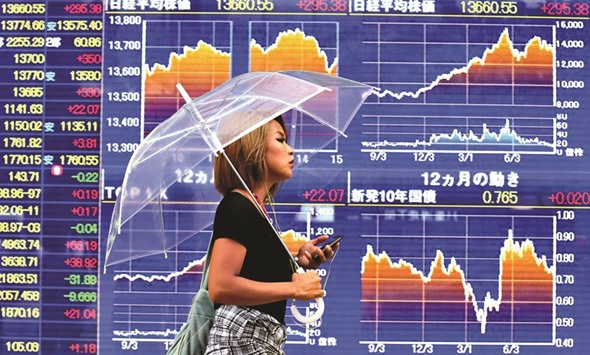Japan’s Nikkei led most Asian stock markets lower yesterday as the yen resumed its march against the dollar and investors nervous about the stuttering global economy tentatively await the start of corporate earnings season.
However, Shanghai surged after data showed Chinese inflation held above 2% for a second-straight month in March, indicating some stability in the economic powerhouse.
The broad regional losses follow last week’s sell-off as traders become increasingly fearful central banks are running out of ideas to ramp up global growth, with the International Monetary Fund expected to lower its forecasts this week.
In Tokyo the benchmark Nikkei ended 0.4% lower as exporters took another hit from the yen’s strength. The unit, which is considered a safe bet in times of uncertainty, has climbed about 5% against the greenback this month alone.
In afternoon trade the dollar was at 107.84 yen, around levels not seen since the Bank of Japan jacked up its stimulus programme at the end of October 2014. Among big-name exporters to take a hit were carmakers Toyota and Nissan.
On Friday top Japanese government spokesman Yoshihide Suga tried to talk down the yen, saying its rise was “one-sided”, while Finance Minister Taro Aso similarly said rapid moves in the currency were undesirable.
His warning had an initial impact as the yen temporarily weakened but it later resumed its rally.
Yesterday Suga added that the government was “closely watching with vigilance, and is ready to take necessary measures depending on situations”.
Marito Ueda, senior dealer at FX Prime, told AFP the market trend had changed to buying back the yen.
“Players are turning pessimistic as the stock market is weak, and the yen’s strengthening will likely continue for a while,” he said.
The generally gloomy mood was evident across Asian markets, with Sydney and Seoul each 0.1% lower, while Wellington, Jakarta and Singapore were also down. But Shanghai closed up 1.6% – and helping Hong Kong to a 0.4% rise – as dealers welcomed figures showing inflation held steady last month.
The consumer price index came in at the same as February’s 2.3%, the latest indication that the world’s number two economy may be stabilising, following a surprise jump in a gauge of factory activity at the start of the month.
The figures will also ease pressure on the government and central bank to add more economy-boosting stimulus after several rounds of easing measures including six interest rate cuts in the year to November.
“Given the upcoming stabilisation of real economic activity, ongoing rebound in property sales and prices, and the recent jump in headline CPI, we think policy easing momentum has likely peaked in the near term,” UBS Group economists wrote in a report ahead of the release.
On crude markets both main contracts retreated after last week’s more than 8% gains with traders looking ahead to Sunday’s meeting of key producers with growing confidence of a deal to limit output.
Brent eased 0.6% to $41.68 and West Texas Intermediate dipped 0.5%, at $39.53. There is a growing expectation that the April 17 meeting, set up by Russia and Saudi Arabia, will see a freeze in production to address a supply glut that has helped send oil prices plunging from levels above $100 in mid-2014.
“The market has positive momentum, so there is a potential for oil to test the highs we saw a few weeks ago,” Michael McCarthy, a chief strategist at CMC Markets in Sydney, told Bloomberg News.

A woman walks past an electronic monitor displaying graphs of Japan’s various stock indices outside a securities firm in Tokyo. The Nikkei ended 0.4% lower yesterday as exporters took another hit from the yen’s strength.


